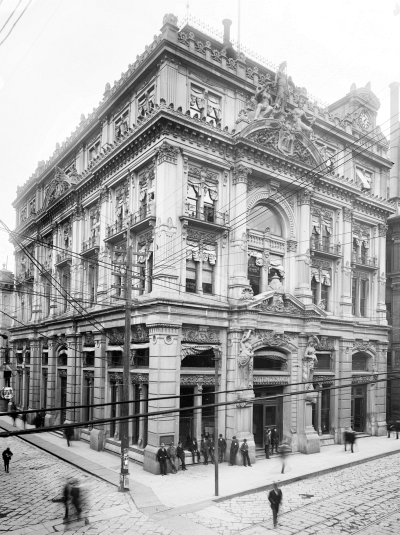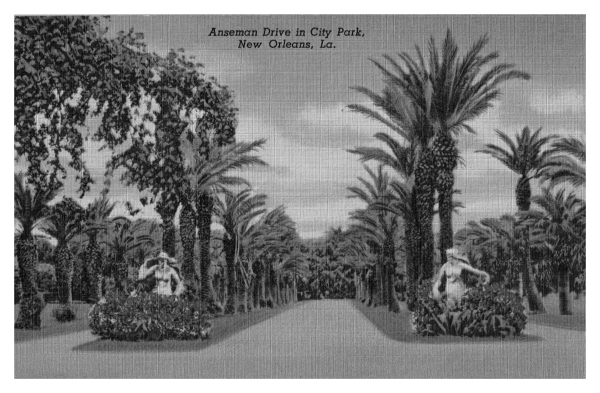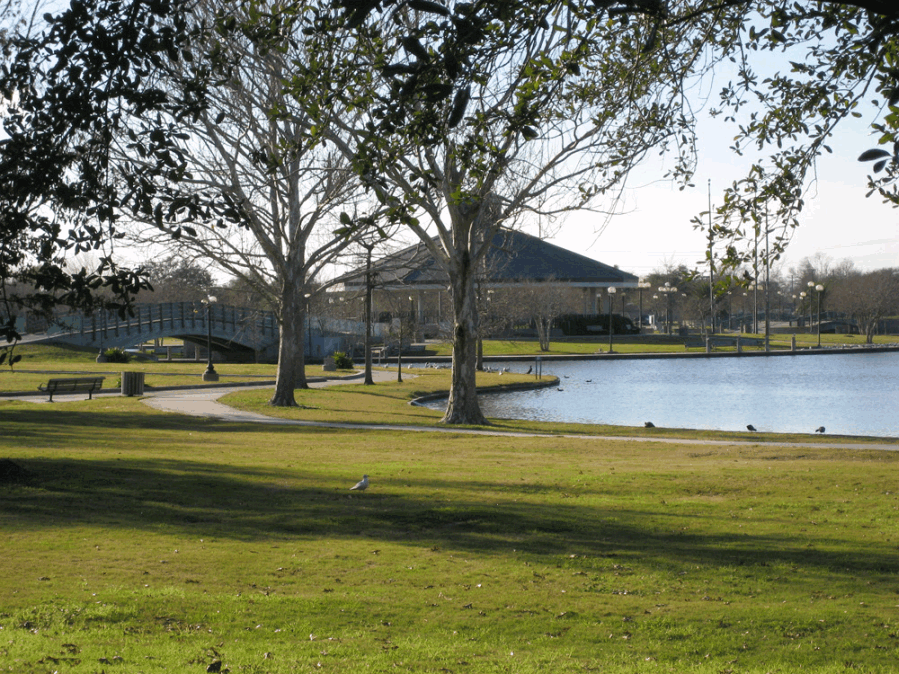|
Today in New Orleans History |
|
|
October 25


NORD Bantam Football Two exhibition games were played at the beginning of the NORD Bantam football season
in 1947 – one before the Tulane-Auburn game on October 25 and a second before the Tulane-Florida game on November
15. Regular games during the season were played at the “Recreation Stadium” (later named Harrell Stadium) at
the corner of South Claiborne and Leonidas and at City Park Stadium. The department of recreation had organized
two six-team leagues, one in the 100-pound class and the other in the 125-pound class. Teams were furnished with competent
coaches and all necessary equipment. (Text and photo from the New Orleans Public Library.)
Earl Cyril Palmer born in New Orleans and raised in the Tremé (October
25, 1924 – September 19, 2008) was
an American rock & roll and rhythm and blues drummer,
and member of the Rock and Roll Hall of Fame. Palmer played on many recording sessions, including Little Richard's first several
albums and Tom Waits' 1978 album Blue Valentine. playing on New Orleans recording sessions, including Fats Domino's
"The Fat Man", "I'm Walkin" (and all the rest of Domino's hits), "Tipitina"
by Professor Longhair, "Tutti Frutti" by Little Richard (and most of Richard's hits), "Lawdy Miss Clawdy"
by Lloyd Price, and "I Hear You Knockin'" by Smiley Lewis. The Pizzati Gate erected in 1910 is one of the the oldest structures in the park. It
is located at what was the main entrance at Alexander Street and City Park Avenue. Donated by Steamboat Captain Salvatore
Pizzati the gate was rededicated on October 25, 2001 in memory of Edgar A. Luminais, an original member of the Board of Commissioners.
The gas-lit ornate cast-iron Belknap Fountain (left of center) was built in 1870 by Jackson Ogden Belknap who used it primarily
as an advertising stand on the neutral ground of Canal Street until it was donated to the park. The bridge was named
in honor of Victor Anseman, the "Father of City Park". In
1904 Mother Cabrini, having heard of his generosity, called upon him to build an asylum and school for orphans to be run by
her Missionary Sisters of the Sacred Heart. The order bought property on Esplanade Avenue near Bayou St. John on the
site of the J. Steckler Seed Company for $18,000 and Pizzati donated $75,000 for the construction of the school, convent,
and apartments for the ophans. Mother Cabrini said, "I learned that Captain Pizzati and his wife always work in
concert. It was Mr. Pizzati who inspired the gift of St. Joseph's new school...Now it is Captain Pizatti himself who
conceives the thought of this orpanage and industrial school". Born on September 12, 1839 in Palermo,
Sicily, he came to the United States in 1808 as a skilled boat master. He began working in association with Captain Grande
on schooners travelling between Spanish Honuras and New Orleans -- he was the first steamship captain to bring bananas into
the United States. He was an admiral in the Honduran navy and commodore of the Oteri-Pizzati Steamship Company which,
when sold to United Fruit Company in 1899, included ten ships, plantations, and several plants. He was a director of Whitney
Central Bank and the Interstate Bank and owner of Columbian Brewery and the Southern Insurance Company. He owned three
plantations in the Buras area, one named for him where he cultivated 14,000 orange trees. Pizzati was
honored by many. Pope Pius X bestowed upon him The Great Cross (Chevalier de Papa) in recognition of
his charitable works. He was a commandotore of the King of Italy, an admiral in the Honduran navy, a colonel of the
staff of Governor J. Y. Sanders, and a special officer of the New Orleans Pollice force (his obituray stated that he
knew and was known by all of the local officers). The City Park gate was his last public donation before
his death on Thursday, December 30, 1915. He was survived by his wife Frances Vallenzano and adopted son Marco Antonio Pizzati.
His home was located at 2502 Canal Street. The Pizzati gate was rededicated in 2001 in honor Edgar Alphonse
Luminais, one of the original Lower City Park commissioners (Audubon Park was then called "Upper City Park" and
City Park was the "Lower City Park"). Luminais was on the board in 1891 when the bylaws were drafted for the City
Park Improvement Association which officially changed the name and acquired control of the park from the City of New Orleans.
He served alongside Victor Anseman, the "Father of City Park" (who was given a $40 salary as the park's keeper).
During his time as a commissioner when the park was largely undeveloped, Luminais oversaw the construction of a fence in the
front of the park, the addition of over 50 iron benches, an octagon-shaped dance pavilion, a ladies rest area near the gate,
a mens rest area near Bayou Metaire, a foot bridge across the bayou, the addition of 50,000 orange, lemon, and fruit trees
as a source of revenue, entertainment for the same purpose, the addition of cattle pasturing in the rear for a fee, a prohibition
against shooting and trapping in the park, and a long-range plan for improvement. During the 1920s visitors entering the Pizzati Gate would be greeted by these one-hundred year-old
bare-breasted ladies (left) on Anseman Avenue. They had originally hovered high above the main entrance to the New Orleans
Cotton Exchange building (above) which was built in 1823 but being readied for demolition in 1920. They were acquired by
the park along with the granite caryatids which flanked the exchange's door and the standing figure between the two ladies
in the photograph. Their tenure in the park was brief – some citizens were outraged. The ladies went on to reside
at Metairie Cemetery and the caryatids can still be seen near the cemeteries on City Park Avenue. The fate of the top
center figure is unknown. Photos from the Louisiana Digital Library. Text from New Orleans City Park (Images of America) by Catherine Campanella
Born on October 25, 1897 to a prominent New Orleans
family, Edmond Souchon II was a passionate lover of jazz and a dedicated physician. He practiced medicine
at Hotel Dieu (as chief of staff), Charity, De Paul, Mercy, and Crippled Childrens Hospitals. He was a founding member of
the Louisiana Surgical Association, a pioneer user of sodium pentathlon as a general anesthetic, and a life fellow of the
American and the International College of Surgeons. He was a director of Pan American Life Insurance Company and the Krewe
of Rex. “Doc Souchon” formed his first band, The Six and 7/8 Sting Band (which played music akin to jazz before
the term had been coined) while attending Tulane University. He played guitar and banjo with many of jazz' best musicians
including Johnny Wiggs, Sherwood Mangiapane, Papa Jack Laine, and Paul Barbarin. He is credited with the historical preservation
of jazz during his lifetime. To accomplish that he featured great local musicians and their music on a WWL radio show, contributed
to Life, Newsweek, and Time magazines, lectured and appeared on national radio and television programs. He had become so
well known for his avocation as a local jazz enthusiast that On May 5, 1961 he appeared on the popular “This is Your
Life!” television show hosted by Ralph Edwards. Souchon played benefits for Crippled Children's Hospital, established
the National Jazz Foundation and the New Orleans Jazz Museum, recorded some 500 songs, was a president of the New Orleans
Jazz Club, and edited Second Line (page ???) from 1951 until his death. He could not read a note of music. In 1967, with
Al Rose, he wrote New Orleans Jazz: A Family Album. “Doc” Souchon died, playing his guitar for friends and family,
on August 24, 1968 in his home at 523 Betz Place. He bequeathed 5000 records and a library of literature to the New Orleans
Public Library and the William Ransom Hogan Jazz Archives at Tulane. He is pictured here (center) with Sharkey and Mildred
Bonano at a party in their home. According to the book A History of Louisiana (1909): It was found that there was no hangman in the colony, so the condemned
prisoners were ordered to be shot. When the day of execution came, hundreds of people left the city. Those who could not
leave went into their houses, closed the doors and windows and waited in an agony of sickening dread to hear the fatal shots.
Only the tramping of soldiers broke the deathlike stillness which brooded over the crushed and helpless city. At three o’clock
on a perfect October afternoon in 1769, the condemned men were led to the Spanish barracks. Lafreniere, it is said, gave
the order to fire. A volley of muskets broke out on the still air, and five patriots went to their death, — the first
Louisianians to give their blood for the cause of freedom. A brief history of the LaFreniere property: The 5000 acre land grant known as Elmwood Plantation was received from Bienville as
a reward for Nicolas Chauvin de la Freniere's service to the colonization of New Orleans. At his death the land passed
to his son, Nicolas de la Freniere, fils [the son]. 427 acres were used for
the multi-million dollar pari-mutual Magnolia Park Inc. Harness Racing
course which opened in 1954 on
Frank J. Clancy Boulevard (now Downs Boulevard). The company built a $100,000 road (David Drive?)
from Airline Highway to the track where there was parking for 5000
vehicles, seating for 2500 in the grandstand (the dining area seated 600) and
accommodations for over 20,000 people on the grounds. Barns provided spaces for 600 horses on the 227
acre track. The remaining 200 acres was later used for housing development.
The harness racing season ran from September to Thanksgiving Day (when the
New Orleans Fairgrounds opened each year). In 1959 the track was renamed
Jefferson Downs which offered nighttime horse racing. It closed in
1965. Lafreniere Park groundbreaking was celebrated in 1977 -- the park was dedicated
and opened in 1982. Photo by Megastealer |
|
|

To receive an update for each day in New Orleans history,
join our facebook page - Today in New
Orleans History.
Analytics |

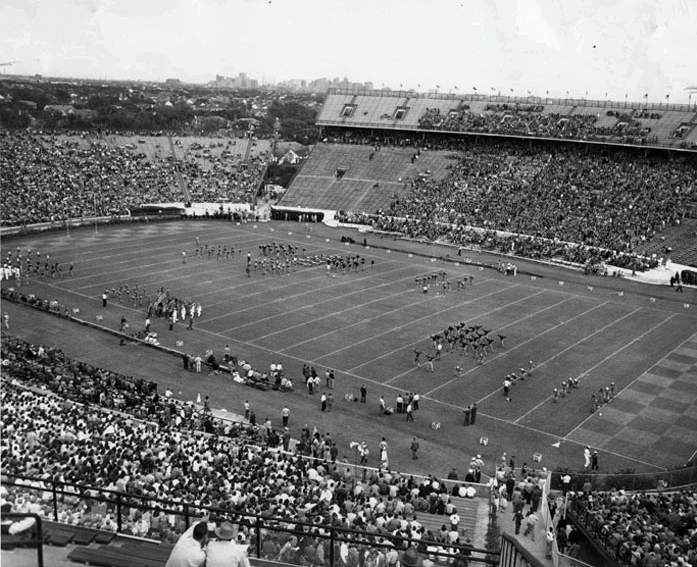

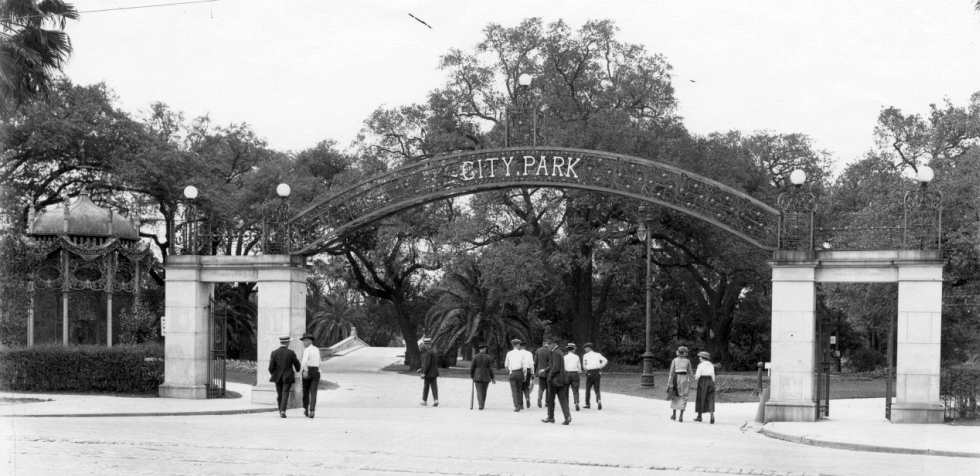
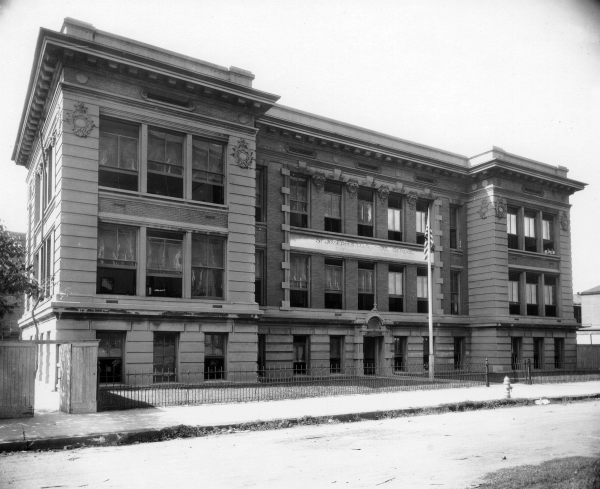 In 1903, the benefactor of this beautiful gate presented a plan for the construction of Saint Joseph's Parochial School at
417 South Roman Street (right), along with the $70,000 cost to build it -- the largest donation to Catholic education yet
in the South. Speaking of his wife and himself, Pizzati said, "We have no children. God has blessed us abundantly.
Let us do for the children of others. Together we make this gift". The school opened in 1904, able to accommodate
800 students. His name “Captain Salvatore Pizzati" was inscribed in stone above the main entrance.
In 1903, the benefactor of this beautiful gate presented a plan for the construction of Saint Joseph's Parochial School at
417 South Roman Street (right), along with the $70,000 cost to build it -- the largest donation to Catholic education yet
in the South. Speaking of his wife and himself, Pizzati said, "We have no children. God has blessed us abundantly.
Let us do for the children of others. Together we make this gift". The school opened in 1904, able to accommodate
800 students. His name “Captain Salvatore Pizzati" was inscribed in stone above the main entrance. 